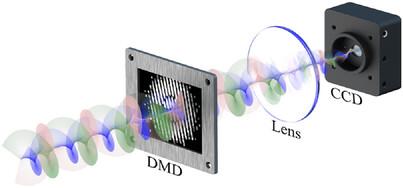Rapid High‐Dimensional State Tomography Enabled by Spatial Autocorrelation
IF 10
1区 物理与天体物理
Q1 OPTICS
引用次数: 0
Abstract
High‐dimensional states encoded in the spatial degrees of freedom of structured light are central to modern optical applications, yet conventional projective tomography requires multi‐step measurements that severely limit efficiency, particularly for complex fields. Here, a fast high‐dimensional tomography technique based on spatial correlation is presented, which directly retrieves modal amplitudes from the central intensity of Fourier‐domain correlation patterns and enables single‐shot estimation of intermodal phases from the surrounding interference fringes. This correlation‐based approach eliminates the need for phase‐shifting interference and reduces the required number of measurements for an ‐dimensional state from to , a total reduction of . By exploiting the polarization insensitivity and kilohertz‐level modulation capability of digital micromirror devices (DMDs), rapid and accurate reconstruction of complex structured light composed of multiple LG modes is experimentally demonstrated. The method provides a scalable platform for high‐throughput optical field characterization with broad applications in optical metrology, high‐speed imaging, and the analysis of both quantum and classical states of light.

利用空间自相关实现快速高维状态层析成像
在结构光的空间自由度中编码的高维状态是现代光学应用的核心,然而传统的投影层析成像需要多步测量,这严重限制了效率,特别是对于复杂的领域。本文提出了一种基于空间相关的快速高维断层扫描技术,该技术直接从傅里叶域相关模式的中心强度中检索模态振幅,并能够从周围的干涉条纹中单次估计模态相位。这种基于相关性的方法消除了相移干扰的需要,并减少了一维状态所需的测量次数,总减少量为。利用数字微镜器件的偏振不灵敏度和千赫兹级调制能力,实验证明了由多个LG模式组成的复杂结构光的快速精确重建。该方法为高通量光场表征提供了一个可扩展的平台,在光学计量、高速成像以及光的量子和经典状态分析中具有广泛的应用。
本文章由计算机程序翻译,如有差异,请以英文原文为准。
求助全文
约1分钟内获得全文
求助全文
来源期刊
CiteScore
14.20
自引率
5.50%
发文量
314
审稿时长
2 months
期刊介绍:
Laser & Photonics Reviews is a reputable journal that publishes high-quality Reviews, original Research Articles, and Perspectives in the field of photonics and optics. It covers both theoretical and experimental aspects, including recent groundbreaking research, specific advancements, and innovative applications.
As evidence of its impact and recognition, Laser & Photonics Reviews boasts a remarkable 2022 Impact Factor of 11.0, according to the Journal Citation Reports from Clarivate Analytics (2023). Moreover, it holds impressive rankings in the InCites Journal Citation Reports: in 2021, it was ranked 6th out of 101 in the field of Optics, 15th out of 161 in Applied Physics, and 12th out of 69 in Condensed Matter Physics.
The journal uses the ISSN numbers 1863-8880 for print and 1863-8899 for online publications.

 求助内容:
求助内容: 应助结果提醒方式:
应助结果提醒方式:


